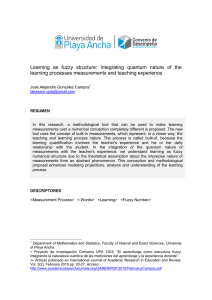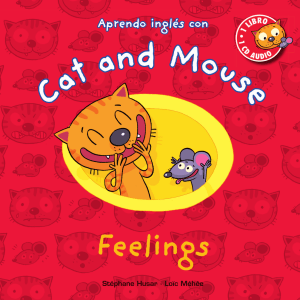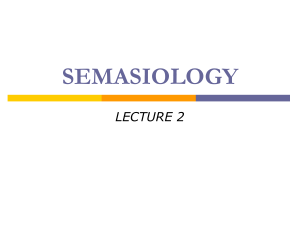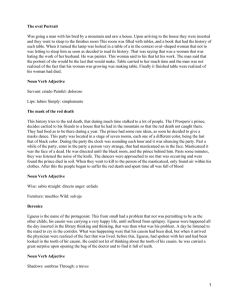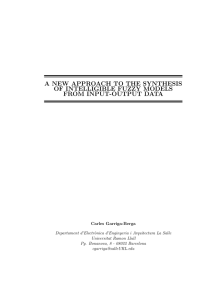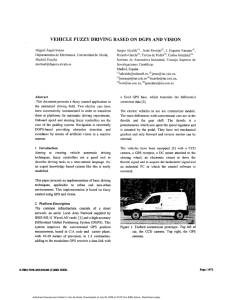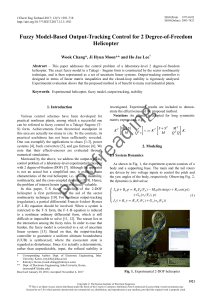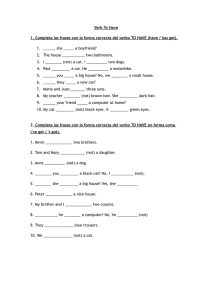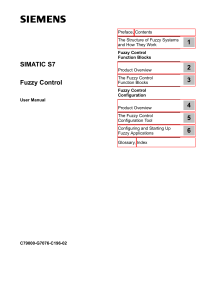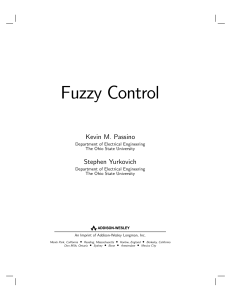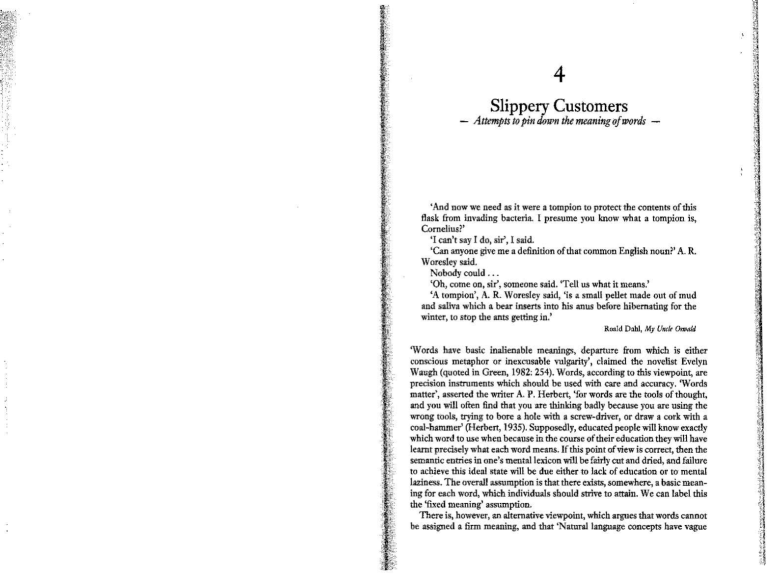
4
Slippery Customers
- Attempts to pin down the meaning ofwords
'And now we need as it were a tampion to protect the contents of this
flask from invading bacteria. I presume you know what a tampion is,
Cornelius?'
'I can't say I do, sir', I said.
'Can anyone give me a definition of that common English noun?' A. R.
Woresley said.
Nobody could ...
'Oh, come on, sit', someone said. 'Tell us what it means.'
'A tampion', A. R. Woresley said, 'is a small pellet made out of mud
and saliva which a bear inserts into his anus before hibernating for the
winter, to stop the ants getting in.'
Roald Doh!, My Unck Oswald
'Words have basic inalienable meanings, departure from which is either
conscious metaphor or inexcusable vulgarity', claimed the novelist Evelyn
Waugh (quoted in Green, 1982: 254). Words, according to this viewpoint, are
precision instruments which should be used with care and accuracy. 'Words
matter', asserted the writer A. P. Herbert, 'for words are ·the tools of thought,
and you will often find that you are thinking badly because you are using the
wrong tools, trying to bore a hole with a screw-driver, or draw a cork with a
coal-hammer' (Herbert, 1935). Supposedly, educated people will know exactly
which word to use when because in the course of their education they will have
learnt precisely what each word means. If this point of view is corrett, then the
semantic entries in one's mental lexicon will be fairly cut and dried, and failure
to achieve this ideal ~tate will be due either to lack of education or to mental
laziness. The overall assumption is that there exists, somewhere, a basic meaning for each word, which individuals should strive to attain. We can label this
the 'fiXed meaning' assumption.
There is, however, an alternative viewpoint, which argues that words cannot
be assigned a firm meaning, and that 'Natural language ooncepts have vague
.,.
:-..
<
:;~:
Basic ingredients
boundaries and fuzzy edges' (Lakoff, 1972: 183). Word meanings cannot be
pinned down, as ifthey were dead insects. Inste~d, they flutter ar~und ~usively
like live butterflies. Or perhaps they should be likened to fish which shther out
of one's grasp: 'Words have often been called slippery customers, and many
scholars have been distressed by their tendency to shift their meanings and
slide out from under any simple definition' (Labov, 1973: 341). Or perhaps
word meanings should be likened to birds wheeling in mid-air: 'The proper
meaning of a word .. . is never something upon which the word sits perched
like a gull on a stone; it is something over which the word hovers like a gull over
a ship's stem' (Collingwood, 1938). This alternative viewpoint can be called
the 'fuzzy meaning' assumption. If it is correct, then it may be extremely difficult to characterize the entries in a person's mental lexicon.
Why should intelligent people hold such divergent opinions? One possibility
is that these are both uninformed, popular viewpoints, which have been put
forward solely on the basis of the personality of the proposer. Perhaps the
notion of a fixed meaning is promoted mainly by lexicographers and schoolmasters, since their jobs would clearly be simpler if words did have precise
definitions. The fictional A. R. Woresley, quoted at the start of the chapter,
obviously enjoyed handing over his dogmatic definition of a tompion, which,
incidentally, is somewhat narrower than most dictionary definitions of the
word. These mostly agree that a tompion or tampion is a plug for stopping an
aperture, but the aperture does not have to belong to a bear - it could belong to
a wide range of things, such as a cask, a gun, or an organ pipe.
In contrast, we might find that the 'fuzzy meaning' adherents were poets and
mystics, such as T. S. Eliot who complained in 'Burnt Norton' that
Words strain
Crack and sometimes break, under the burden,
Under the tension, slip, slide, perish,
Decay with imprecision, will not stay in place,
Will not stay still.
Unfortunately, this simple solution m11 not work. It turns out that there is no
simple correlation between the type of person and the viewpoint held. Wellknown and respected philosophers, psychologists and linguists are found on
each side of the debate- though, on balance, philosophers have tended to favour
the fixed meaning viewpoint while psychologists often opt for fuzziness
Qohnson-Laird, 1983). As far as the mental lexicon is concerned, we need to
know whether it is possible to assign a firm definition to any word or whether
words inevitably have fuzzy meanings. The answer will obviously affect ourvi:ew
of how people represent them in their minds. In this chapter, therefore, we 'vill
consider the fixed-fuzzy issue. In the ne:r..'t, we will discuss the mental representation of word meaning in more depth (chapter 5). Mter that we will move on to
the organization of words in the mind in relation to one another (chapters 6-7),
and then examine how children learn what words mean (chapter 8).
Slippery customers
41
In what follows we shall concentrate -on the information which might be in a
person's mind rather than on trying to come to grips with the abstract philosophical problems involved in 'the batHing word "meaning"' (Quine, 19611
1985: 49). The opinions of philosophers will be mentioned only when these
seem likely to illuminate the issues under discussion. (For a useful summary of
the differing standpoints of philosophers and psychologists see johnson-Laird
1983.)
'
Similarly, we shall not be particularly concerned with what has been called
'the inscrutability of reference' (Quine, 1971: 142), the complex relationship
between a word and the real-world thing it labels. Most people assume that
words are linked to things via 'concepts', though exactly how is unclear (see
figure 4.1).
Thing
Figure4.1
Tlwwordandthingprobkm
The intermeshing of words and concepts is an area of study which is 'a
morass of comple.....:ity and ignorance . . . The intricate connection between the
labels people use and their conceptions of the things labeled is poorly understood' (Milter and Johnson-Laird, 1976: 212). People argue as to whether there
is an abstract layer of concepts which is separate from word meaning or
whether the word meanings and the concepts are identical (Aitchison, 1985).
In this book we will assume, first, that people translate the real wortd Into
'concepts' which in cases such as tiger, moon reflect the external world fairly
well, in that there is likely to be considerable agreement over what they are,
even between people speaking different languages. Second, we will treat the
'meaning' of a word as overlapping with the concept to a lar~ extent, though
not necessarily totally: the overall concept may extend beyond the sections
labelled with a ·word (figure 4.2). This viewpoint will hopefully become clearer
as the book progresses.
Let us now consider the fixed-fuzzy issue. We will begin by outlining some
ideas put forward by proponents of the fixed meaning viewpoint.
.:::
~~
42
Basit ingredients
Figure 4.2 The relatitmslrip between concepts and word meaning
Snapshots and check~l.ists
Yes. I remember Adlestrop The name, because one afternoon
Of heat the express~train drew up there
Unwontedly. It was late june.
·;:..
:.:
·.,.
These lines from Edward Thomas's poem 'Adlestrop' exemplify the simplest
possible viewpoint that one could have offixed word meaning. They suggest that
we have words filed as a series of snapshots. The word Adlestrop conjures up a
parii.cular photo from the file, in this case a view through a train window.
It seems likely that we all have our Adlestrops: psychologists sometimes talk
about 'episodic memory', cases in which a particular episode is remembered
with great clarity, sometimes with a word label attached (Tulving, 1972;
Baddeley, 1976). However, there are a number of difficulties with the snapshot
viewpoint as a general theory of word meaning. One major problem is that we
have usually seen any object we are talJUng about from a number of angles.
Take the word cat. Are we talking about a cat which is awake and wafking
about? Or one which is curled up asleep? Or one which is licking milk from a
saucer? At the very least we need a number of different snapshotsj representing
a cat in each of these positions. Furthermore, cats can be different colours and
sizes, often with quite personal characteristics, as with T. S. Eliot's mystery cat,
Macavity:
Macavity's a ginger cat, he's very tall and thin;
You would know him if you saw him, for his eyes are sunken in.
His brow is deeply lined with thought, his head Is highly domed;
His coat is dusty from neglect, his whiskers are uncombed.
So do people need a whole dossier ofphotographs for every single cat they have
ever seen in every single position? And if so, how could they possibly label a
new cat as cal if it wasn't in the dossier?
Slippery customers
43
Moreover, the more general a term is, the more difficult it is to specify an
associated image. Consider the term animal: 'lf the generic image is four~
footed, how is it that we can identify man as an animal; ifit is short-necked how
can we identify the giraffe?' (Brown, 1958: 85).
These problems explain why the notion that meaning involves a mental
image has generally proved unsatisfactory. It had some popularity at the begin~
ning of the century, when the influential psychologist Edward Bradford
Titchenor claimed to have a fixed mental image for every word. For him, cow
was 'a longish rectangle with a certain facial expression, a sort of exaggerated
pout', and ·the word meanir~g called to mind 'the blue~ grey tip ofa kind ofscoop
which has a bit otyellow about it' (Titchenor, 1909, quoted in Brown, 1958:
90). But since then the vast majority of psychologists have abandoned the idea
that word meaning involves any straightforward imagery, apart from the
occasional Adelstrop-type snapshot.
These obsenrations suggest that a word such as cat refers not to the image of
a cat but to a somewhat more abstract amalgam. Anyone who understands the
word cat must have performed some type of analysis which has isolated the
essential 'cattiness' involved in being a cat. Perhaps it is these essential charac~
terisdcs which constitute its basic meaning.
This is the viewpoint of a numl:ler of philosophers. They argue that in order
to capture the meaning of a word one should establish a set of'necessary and
sufficient conditions', in other words, a list of cond'itions which are absolutely
necessary to the meaning of the word, and which taken together are sufficient
or adequate to encapsulate the meaning. Take the word square. This has four
necessary conditions (Smith and Medlin, 1981):
1
2
3
4
a closed, flat figure
having four sides
all sides are equal in length
all interior angles are equal.
Each of these conditions is, by itself, necessary in order for something to be a
square, and when combined together they are sufficient to define and identify a
square, and only a square. Presumably anyone who understands the concept of
a square must be aware of these conditions, even if they could not express them
in quite this way. These conditions are also called 'conditious of criteri.ality' or
'criterial attributes' since they are the criteria which one uses to judge whether
something is a square or not.
We may refer to this as a 'che1::k-list' theory (Fillmore, 1975). In brief, this
theory suggests that for each word we have an intem·allist of essential charac~
teristics, and we label something as cat, or square, or cow only ifit possesses the
'criterial attributes', which we subconsciously check off one by one. This
'check~list' theory is intuitively satisfying to some people, perhaps because it is
fairly familiar, as many dictionaries im_plicitly work on a check-list principle.
44
.Basic ingredients
However, the check-list theory also involves a number of problems. Let us consider some of these.
A maror problem with the check-list theory is deciding which attributes go
on to the list. Only a very few words have a straightforward set of necessary
conditions, though occasionally officials can decree that words have fixed
meanings within a particular context, as in the following bureaucratic definition ofa cow: 'A cow is a female bovine animal which has borne a calf, or has, in
the opinion of the Minister, been brought into a herd to replace one which has
borne a calf (quoted in a letter to The Times).
However, most people's notion of cow would perhaps be more like that of
the following ten-year-old: 'A cow is a mammal. It has six sides- right, left, an
upper and below. At the back it has a tail on which hangs a brush. With this it
sends the flies away so that they do not fall into the milk. The head is fot the
purpose of growing horns and so that the mouth can be somewhere. The horns
are to butt with and the mouth is to moo with. Under the cow hangs the milk. It
is arranged for milking. When people milk, the milk comes and there is never
an end to the supply' (Gowers, 1986: 43). This child seems to have the word
cow in its active mental lexicon. But bow much of this description Involves the
actual 'meaning' of cow and how much is additional, non-essential information? Is it possible to isolate out from people's overall knowledge a basic hard
core of fixed meaning?
A number oflinguists and philosophers have claimed that such a distinction
is a useful one. Like the Greek philosopher Aristotle, they assutne that words
have a hard core of essential meaning which it is, in principle, possible to
extract and specify. Surrounding this core are a number of fairly accidental
facts which can be added or omitted without altering the basic meaning in any
important way. The core meaning is assumed to be entered in some kind oflin~
guistic dictionary, whereas the surrounding non-essential facts are stated in an
encyclopaedia of general knowled·ge. Two influential resea'rchers who
promoted this viewpoint claimed that they were trying to characterize
speakers' internal knowledge of their language, and so seem to be suggesting
that there may be a division between a lexicon and an encyclopaedia in the
human mind (Katz and Fodor, 1963).
If this is likely to be so, how might one identify the semantic core? Some
people propose using the 'That's impossible' test. Suppose you were analysing
the meaning of the word bachelor. If you say to someone: 'Harry is a bachelor
who has been married ten years\ you would be likely to get the response:
''That's impossible. Bachelors can't be married, unless you're talking about
Harry's first degree or using the word metaphorically.' This suggests that
UNMARRIED is a core condition of bachelor. You would probably get a
similar response ofincredulity if you said: 'My aunt Fenella is a bachelor', on
the gro·unds that a bachelor has to be male. Similarly, if you stated': 'My baby
brother is a bachelor' or 'My tadpole is a bachelor', you would probably be told
that bachelors have to be adult and human. So HUMAN, MALE, ADULT,
Slippery customers
'
:~
45
UNMARRIED might be regarded as components of the 'real meaning' of
bachelor, in that each of these charatteristics seems tD be abS'oluteJy necessary
in order for a person to be labelled bachelor. Of coune, people might well have
additional knowledge or beliefs about bachelors. For example, they might
expect bachelors to be childless or to drive fast cars. But this type of information would be a non~necessary extra, which might help in a conversation with a
bachelor but would not have anything to do with the meaning of the word.
The idea of sorting out a core meaning which can be distinguished from
encyclopaedic knowledge is an enticing one. Unfortunately, however, there are
relatively few words which can be sorted out in this apparently useful way.
Most words cause considerably more difficulty. Take the word tiger. Everybody claims to know what a tiger is but no one is at all clear about exactly what
makes a tiger a tiger.
A tiger is a 'large Asian yellow-brown black-striped carnivorous maneless
feline' according to one dictionary (COD), and 'a very large Asiatic cat having a
tawny coat transversely striped \vith black' according to another (LCBD).
Which of these characteristics are essential? Here the 'That's Impossible' test
is likely to yield inconclusive results. Most people would acceptthat ANIMAL
is a necessary condition of tigerhood, since if you said 'Harry's tiger's not an
animal' you would probably get the reply: 'Then it can't be a tiger.' People
might also agree that tigers needn't be carnivorous. If you said: 'Harry's tiger's
a vegetarian', it would be quite plausible to receive the reply: 'I'm not surprised, he probably can't afford to feed it on meat.' What about stripiness? 'Of
course tigers have to be striped. Whoever heard ofan unstriped tiger?' say a few
people. But many people are more Jrermissive and make comments such as: 'I
read in the paper that you can have white tigers, so stripiness c·an't be essential'
-though white tigers, incidentally, are quite a disappointment: they are in fact
honey-coloured, with faint stripes.
The general permissiveness over core characteristics is a problem. 'It's not at
aU hard to convince the man on the street that there are three legged, lame,
toothless, albino tigers, that are tigers all the same .. . What keeps them ti.gers?'
(Armstrong et aL, 1983). How does one cope with these apparently 'careless
concepts'?
T he check-list viewpoint, therefore, is faced with two critical problems.
First, it seems to be extremely difficult to decide what goes on to the check-list,
since there appears to be no obvious way to draw a dividing line between essential and non-essential characteristics. Second, for some things the check-list
seems to be virtually non-existent, since there appear to be hardly any necessary conditions.
Does this mean that the fixed meaning assumption has to be abandoned if, in
practice, it is impossible to fix the meaning for most words? A well-known
philosophical viewpoint is that words do indeed have a fixed, correct meaning,
but that only a few experts know it (Putnam, 1975). Ordinary people must
consult these experts if they need to know about the essential nature of
_,
" •
::
'I' ' ' ' ' "' ',,,, ..,.
~·
46
..,.
something. Only a specialist, for example, might be able to specify the true
natUre of gold or arsenic. The probtem here is that specialists sometimes
d1sagree, and sometimes change their mind. This leaves us with a quite
extraordinary state of affairs: that there might be a 'real meaning' of something
which at present nobody can actually specifY. But this type of me·aning, even if
it exists, is not very interesting to someone working on the mental lexicon:
'Either it is in an expert's mind (though no one can know for sure that the right
meaning is there), or it is in no one's mind and accordingly an idle wheel in the
intellectual traffic of the world' Oohnson-Laird, 1983: 195).
In brief, even ifthe 'true meaning' of, say, gold, measles, or arsenic exists in the
abstract or in the minds of experts, it is clear that we non-experts bumble along
quite happily with a working approximation of our own for mest words, as
indeed the philosophers admit. Moreover, even if we are told about an expert's
viewpoint we sometimes choose to ignore it. For ·example, botanists tell us that
an onion is simply a kind oflily (Dupre, 1981), information which seems to be
unnecessary for a working knowledge of onions and lilies, and even if known is
likely to be disregarded. We conclude, therefore, that even if there is somewhere a 'true' meaning for each particular word, this meaning is fairly irrelevant in relation to the mental lexicon.
In this section, then, we have found that, for some words, it seems to be
impossible to identifY a firm semantic core. Does this mean that the notion of
fixed meanings must be abandoned? Yes it does, according to the fuzzy meaning supporters. Let us now consider their viewpoint.
f
1.';
Slippery custamers
Basicingredients
47
~
..
.
Figure 4.3 Vase, cup or bowl?
.
I fit was just that they disagreed with one another, one could simply have said
that people's mental lexicons differ. But it turned out that individuals were
inconsistent in their own responses. For example, after confirming that a particular container was likely to be called a bowl when it was seen empty, Labov
then asked the students what they would call it when it was filled with various
things. A bowl remained a bowl if it was full of mashed potatoes but tended to
be relabeUed as a vase ifit contained flowers, and a cup ifthere was coffee in it.
Labov notes: 'A goal of some clear thinkers has been to use words in more
precise ways. But though this is an excellent and necessary step for technical
jargon, it is a self-defeating programme when applied to ordinary words' ( 1973:
341}. Fuzzy edges, then, seem to be an intrinsic property of word meaning.
Let us now turn to the family resemblance syndrome. This can be illustrated
by a mythical family called the Mugwumps. The Mugwumps, let us say, have
certain family characteristics which tend to surface in generation after generation of Mugwumps: ears which stick out, squint-eyes, eyebrows which meet in
the middle and a ferocious temper. However, it might well happen that
although two or three of these features occurred in lots of Mugwumps, there
was no single Mugwump who actually had all ofthem. The same thing happens
in relation to words.
The family resemblance syndrome has been described vividly by the philosopher Wittgenstein {1958: 66): 'Consider ... the proceedings that we call
"games". I mean board-games, card-games, ball-games, Olympic games, and
so on. What is common to them all? - Don't say: "There must be something
common, or they would not be called 'games'" - but look and see whether
there is anything common to all. -For if you look at them you will not see
something that is common to all, but similarities, relationships, and a whole
series of them at that. To repeat: don't think, but look! - Look for example at
{.
Fuzzy edges and family resemblances
Fuzzy meaning supporters argue that word meanings are inevitably fluid, for
two reasons: the 'fuzzy edge phenomenon' and the 'family resemblance
syndrome'. Let us illustrate these. Words have fuzzy edges in the sense that
there is no clear point at which one word ends and another begins. This was
demonstrated by the sociolinguist William Labov when he showed students
pictures of containers and asked them to label each as either a cup, a vase, or a
bowl {Labov, 1973). The students all agreed on certain shapes. For example,
they all considered tan thin containers without handles to be vases and low flat
ones to be bowls. But they were quite confused when faced with something that
was in between the two. Was it a vase or a cup? And suppose vase and bowl
shapes were given handles {figure 4.3), what then? They had difficulty in
deciding, and they came to different conclusions from one another. As Labov
pointed out: 'In any kitchen, there are many containers that are obviously
bowls, cups, mugs, and dishes. But there are others that might be called cups or
. might not; or might be a kind of cup, according to some, but a kind of dish
according to others' (Labov, 1973: 340).
.·
~
..
49
Basic ingredients
Slippery customers
board games, with their multifarious relationships. Now pass to card-games;
here you find many correspondences with the first group, but many fe atures
drop out, and others appear. When we pass next to ball-games, much that is
common is retained, but much is lost. -Are they all "amusing"? Compare chess
with noughts and crosses. Or is there always winning and losing, or competition between players( Think of patience. In ball games there is winning and
losing; but when a child throws his ball at the wall and catches it again, this
feature has disappeared. Look at the parts played by skill and luck; and at the
difference between skill in chess and skill in tennis. Think now of games like
ring-a-ring-a~roses; here is the element of amusement, but how many other
characteristic features have disappeared! And we can go through the many,
many other groups of games in the same way; can see how similarities trop up
and disappear.'
Wittgenstein concludes that although every game has some similarity with
other games, there is no one factor which links them all. We are faced with 'a
complicated network of similarities overlapping and criss-crossing' (Wittgenstein, 1958: 66). He continues: 'I can think of no better expression to
characterize these similarities than •family resemblances"; for the various
resemblances between members of a family: build, features, colour of eyes, gait,
temperament, etc. etc. overlap and criss-cross in the same way.- And I shall
· say: "game:s" form a family' (Wittgemtein, 1958: 67) (figure 4.4).
The word ga~, then, illustrates the family resemblance syndrome clearly.
But this word is not an isolated, special instance and there are numerous other
equally common ones which exhibit the same problem, such as furniture,
employment, or vegetable.
48
The fixed- fuzziness issue
Let us now summarize the fixed-fuzziness issue. There are a small number of
words such as square or bachelor which appear to have a fiXed meaning, that is,
they are words for which we can specuy a set of necessary and sufficient
conditions. The majority of words, however, do not behave in this way. They
suffer from one or more of the following problems: first, it may be difficult to
specify a hard core of meaning at all. Second, it may be impossible to tell where
'true meaning' ends, and encyclopaedic knowledge begins. Third, the words
may have 'fuzzy boundaries' in that there might be no clear point at which the
meaning of one word ends and.another begins. Fourth, a single word may apply
to a 'family' ofiiems which all overlap in meaning but which do not share any
one common characteristic.
These are insuperable obstacles to the fixed meaning viewpoint. We
conclude that, for the majority of words, meanings in the mind are fuzzy, not
fixed. Language, it seems, has an in built 'property of"limited sloppiness"' and
'only some areas are marked by a degree of"terminolagization'" - the setting of
firm boundaries (Weinreich, 1966: 190, 186). In the next chapter we shall
consider how humans cope with this hazy mush of meanings. However, before
we tackle this topic we need to consider one further point. Can we assume that
everyone operates with the same meanings? Or is there a huge discrepancy
from person to person( Let us discuss this problem.
Plank, slab, block, brick, cube
Figure 4. 4 Family resemhlancts amonggames
'Plank, slab, block, brick, cube' are the first five words spoken in T om
Stoppard's play Dugg's Our Pet. A man called Charlie is planning to build a
platfonn, and he shouts instructions about the pieces he wants thrown to him.
A plank, a slab, a block, a brick and a cube duly arrive, in that order. But then
strange things start to happen. When Charlie shouts 'Plank' again, a block
arrives. When he calls for a block, he gets a brick, and when he yells 'Cube',
there is no response. What has gone wrong?
It transpires that Charlie and the thrower are speaking a different language.
In Charlie's language, words such as plank, block and cube have their
,.
,.
;
Basic ingredients
cbnventional meaning. But to the thrower they mean something different,
perhaps 'Here!', 'Next!' and 'Tha.nkyou!' If Charlie had needed only the first
five pieces named the discrepancy might never have been discovered, since the
thrower's language fitted in sufficiently well with the context of platformbuilding for the work to proceed.
This is an extreme and literary situation. But the play makes a serious point.
If I ask someone to fetch me a glass of water and a glass of water arrives, it is
possible that the person fetching it simply thinks that the word water means
'colourless liquid' and so chose randomly between water, gin and vodka. Only
if there is a misunderstanding, and a tumblerful of vodka arrives, would I
suspect a problem. And such misunderstandings might continue for some time,
only being discovered by chance, as when I overheard a schoolchild who was
viewing lemurs at the London Zoo enquire of her teacher: 'Please, miss, are
they extinct?', or when a horrified mother heard her teenage daughter say to an
elderly lady: 'Can I relieve you of your nether garments?' as she helped the
visitor out of her coat.
Furthermore, we are not in general on the look-out for problems ofthis kind.
Ifsomeone uses a word strangely we rarely assume that their use ofit i:s defective
by our standards. Ifsomeone said, 'Look out! There's a rhinoceros sitting in the
tree just above your head', we would assume that they were either joki:ngor mad.
We would be uolikely to consider the possibility that the speaker thought rhinoceros meant 'pigeon''. In brief, In real life we operat e by assuming that, for the
most part, people have beliefs similar to our own about what words mean (see
Pulman, 1983,Sperber and Wilson, 1986, for further discussion.on this). w.e as
psycholinguists work in the same way. We assume that there will be sufficient
overlap between the meaning of words in the minds ofdifferent speakers for us
to come to some useful conclusions - though we shall be on the look-out for
discrepancies which might reveal idiosyncratic ideas.
50
Summary
In this chapter we examined the controversy between those who claim that
words have fixed meanings and those who argue that word meanings are essentially fluid .
Our conclusion was that, for many words, it is impossible to specify hardcore
semantic information, and equally impossible to distinguish essential meaning
from encyclopaedic knowledge. There is no firm boundary between the meaning ofone word and another, and the same word often applies to a whole family
of things whlch have no overall common characteristic. We concluded, therefore, that words are indeed slippery customers, with vague boundaries and
fuzzy edges.
But if words are so fuzzy, how do speakers cope with this hazy mush of
meanings? Thi's is the topic of the next chapter.
5
Bad Birds and Better Birds
- Prototype theories -
The Hatter ... had taken his watch out of his pocket, and was looking
at it uneasily, shaking it every now and then, and holding it to his ear ...
'Two days wrong!' sighed the Hatter, 'I told you butter wouldn't suit
the works!'...
Alice had been looking over his shoulder with some curiosity. 'What a
funny watch!' she remarked. 'It tells the day of the month, and doesn't tell
what o'clock it is!'
Lewis Carroll, Alice's Ativent'!res ill WIJnikrland
Ifwords have a hazy area of application, as we decided in rhe last chapter, we
are faced with a serious problem in relation to the mental lexicon. How do we
manage to cope with words at all? The quotation above from Alice in Wonderland gives us a clue. Alice appears to have some notion of what constitutes a
'proper watch'. This enables her to identify the butter-smeared object owned
by the Hatter as a watch, and to comment that it is a 'funny' one.
A feeling that some examples of words may be more central than others
appears to be widespread, as shown by a dialogue between two small girls in a
popular cartoon strip:
Augusta What colour did you say the Martians are?
Friend Green.
Augusta What sort of green? I mean are they an emerald green or a pea green or an
apple green or a sage green or a sea green or what?
Friend Well I think they're a sort of greeny green.
Humans, then, appear to find some instances of words more basic ·than
others. Such an observation may shed light on how people understand their
meaning. Take birds. Perhaps people have an amalgam ofideal bird characteristics in their minds. Then, if they saw a pterodactyl, they would decide
whether it was likely to be a bird by matching it against the features of a birdlike bird, or, in fashionable terminology, ·a 'prototypical' bird. It need not have
